Around three decades ago, we weren't certain that other stars had planets orbiting them. Scientists naturally thought there would be, but they had no evidence. Now, not only do we know of more than 6,000 confirmed exoplanets, but we can watch as baby planets take shape around distant stars.
When stars form, they're surrounded by rotating disks of gas and dust called protoplanetary disks. Planets form in these disks, and in recent years, ALMA (Atacama Large Millimeter/submillimeter Array has examined many of these disks. It's made headlines by finding telltale signs of planets forming, as they seem to clear orbital paths in the disks.
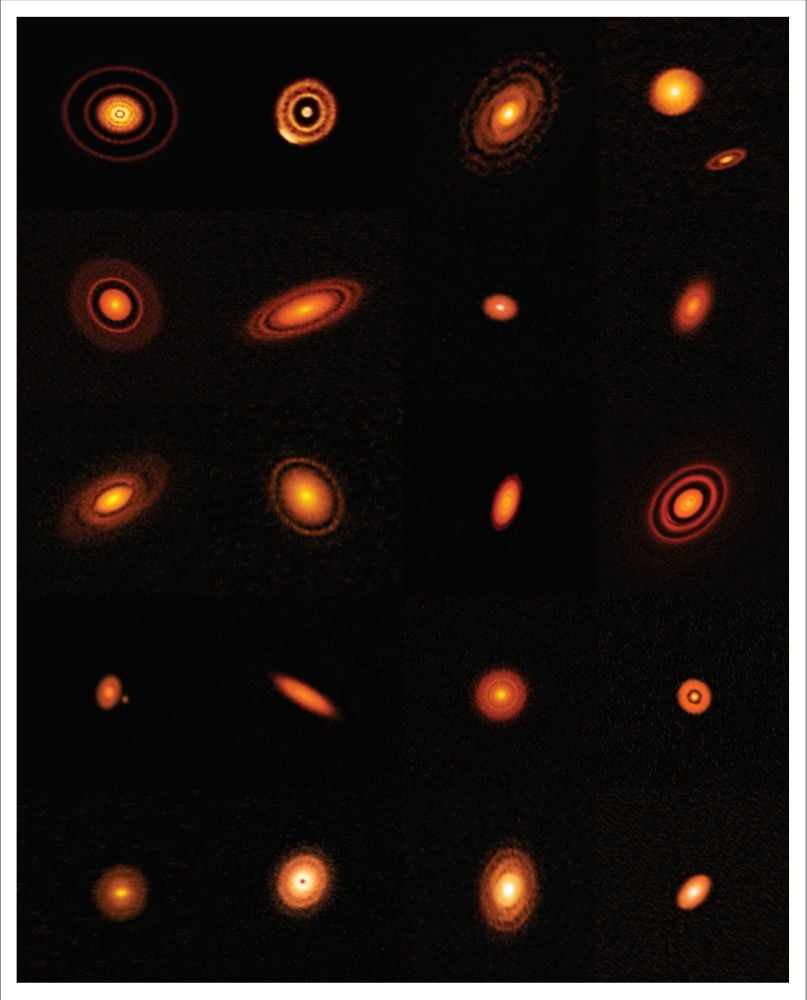 This image shows some of the protoplanetary disks imaged by ALMA. The gaps and rings show where planets are forming and creating lanes in the gas and dust. Image Credit: ALMA (ESO/NAOJ/NRAO), S. Andrews et al.; NRAO/AUI/NSF, S. Dagnello
This image shows some of the protoplanetary disks imaged by ALMA. The gaps and rings show where planets are forming and creating lanes in the gas and dust. Image Credit: ALMA (ESO/NAOJ/NRAO), S. Andrews et al.; NRAO/AUI/NSF, S. Dagnello
Other telescopes have studied these young protoplanetary disks, too, and uncovered their own evidence of planets forming. Astronomers working with the ESO's Very Large Telescope (VLT) and its SPHERE instrument found spiral arm patterns in the disk around the star HD 135344B. While those patterns suggest the presence of a planet, there was no direct evidence.
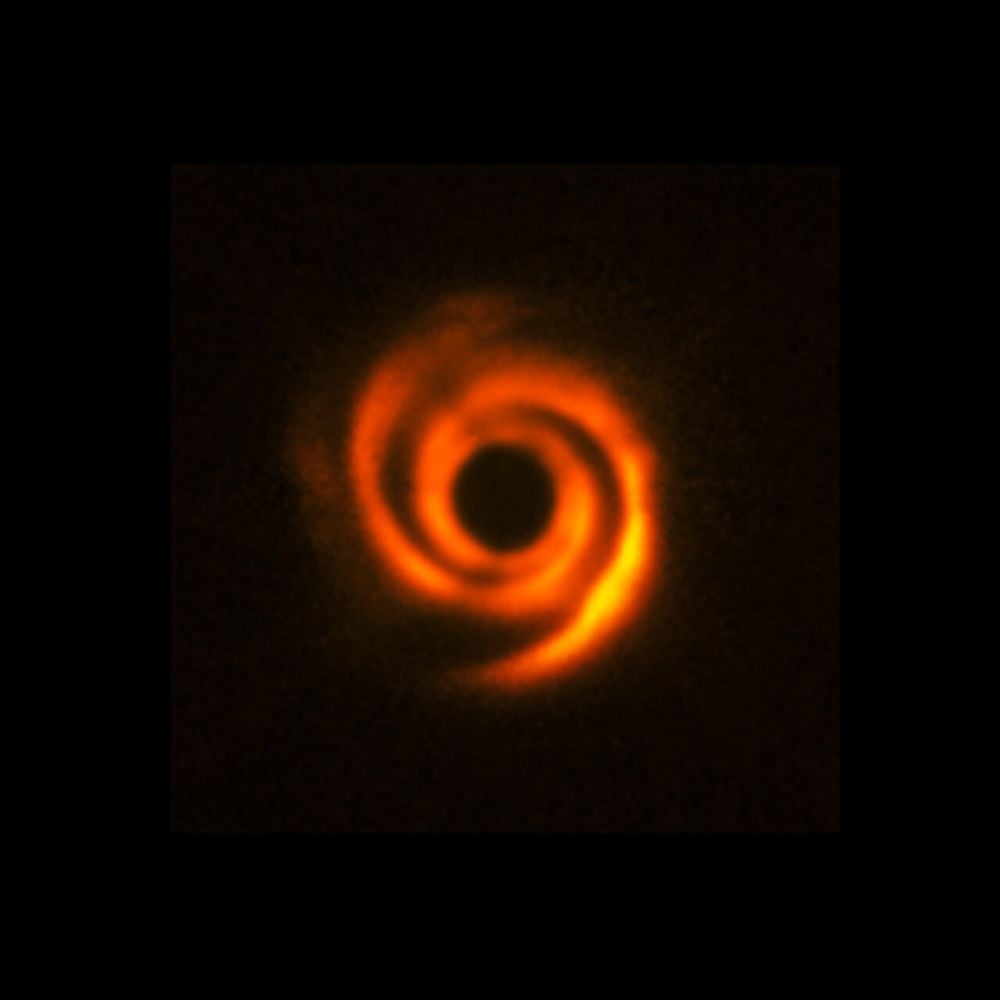 The SPHERE instrument on the ESO's Very Large Telescope observed these spiral arm patterns around HD 135344B. This instrument suggested the presence of a planet, but didn't provide any direct evidence that one was there. The central black region shows how the star itself is blocked by the telescope's coronagraph. Image Credit: ESO/T. Stolker et al.
The SPHERE instrument on the ESO's Very Large Telescope observed these spiral arm patterns around HD 135344B. This instrument suggested the presence of a planet, but didn't provide any direct evidence that one was there. The central black region shows how the star itself is blocked by the telescope's coronagraph. Image Credit: ESO/T. Stolker et al.
Now astronomers working with another of the VLT's instruments, the Enhanced Resolution Imager and Spectrograph, may have found direct evidence of a gas giant forming around the star. The discovery is presented in a research letter titled "Unveiling a protoplanet candidate embedded in the HD 135344B disk with VLT/ERIS" published in Astronomy and Astrophysics. The lead author is Francesco Maio, a doctoral researcher at the University of Florence, Italy.
"High-angular-resolution observations in infrared and millimeter wavelengths of protoplanetary disks have revealed cavities, gaps, and spirals," the authors write in their research. "One proposed mechanism to explain these structures is the dynamical perturbation caused by giant protoplanets."
Previous research examined the disk around HD 135344B. ALMA observations revealed spiral arms and hints of a massive planet forming, and other features like a blob. This research has refined those observations with more powerful instruments.
"We identified the previously detected S1, S2, S2a spiral arms and the “blob” features southward of the star," they added. They also found a new point source at the base of the S2 spiral arm. They identify it as a gas giant with about 2 Jupiter masses.
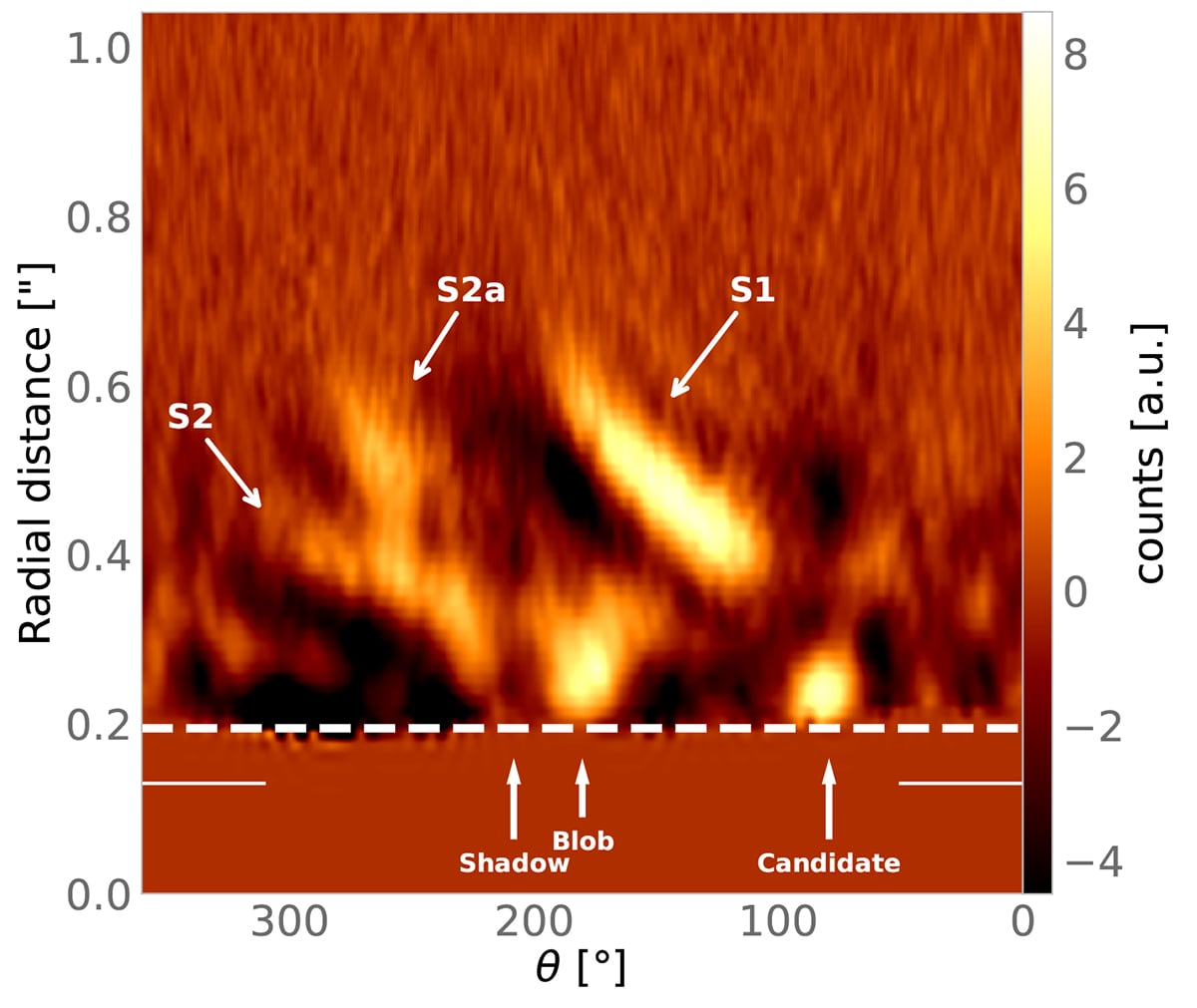 This figure shows the two spiral arms and the candidate companion. The shadow, marked by the arrow, is also evident, along with a fully shadowed region highlighted by the horizontal solid line. This visualization of the shadows further confirms the extended nature of the blob south of the star and highlights that it is part of the S2 spiral interrupted by the shadow. Image Credit: Maio et al. 2025. A&A
This figure shows the two spiral arms and the candidate companion. The shadow, marked by the arrow, is also evident, along with a fully shadowed region highlighted by the horizontal solid line. This visualization of the shadows further confirms the extended nature of the blob south of the star and highlights that it is part of the S2 spiral interrupted by the shadow. Image Credit: Maio et al. 2025. A&A
These observations are markedly different from previous observations showing the telltale gaps carved out by exoplanets. With those images, researchers could only deduce that planets created them. And when it comes to spirals, there were other potential explanations, too. "Spiral arms can also be explained by other mechanisms not involving an external perturber," the researchers write, explaining that gravitational instability could potentially create the arms, as could shadows. A 2021 paper explained that asymmetries in circumstellar disks can cast shadows on other regions of the disk. Those shadows create regions of low pressure that could trigger the formation of spirals.
But this time, astronomers have detected light signals from the planet itself.
“What makes this detection potentially a turning point is that, unlike many previous observations, we are able to directly detect the signal of the protoplanet, which is still highly embedded in the disc,” says Maio, who is based at the Arcetri Astrophysical Observatory, a centre of Italy’s National Institute for Astrophysics (INAF). “This gives us a much higher level of confidence in the planet’s existence, as we’re observing the planet’s own light.”
This system is 440 light years away, and the planet is about twice as large as Jupiter. It's about as far away from its star as Neptune is from the Sun (~4.5 billion km).
A different group of researchers have also discovered spiral arms in the disk around another star. It's named V960 Mon, and the researchers used the ERIS instrument on the VLT to observe it. They say they discovered a companion object forming in the disk, and their discovery is in The Astrophysical Journal Letters. It's titled "VLT/ERIS Observations of the V960 Mon System: A Dust-embedded Substellar Object Formed by Gravitational Instability?" and the lead author is Anuroop Dasgupta from the European Southern Observatory.
"V960 Mon is an FU Orionis object that shows strong evidence of a gravitationally unstable spiral arm that is fragmenting into several dust clumps. We report the discovery of a new substellar companion candidate around this young star," the researchers report. It's deeply embedded in the disk, and is close to some previously reported clumps in the disk around V960 Mons. "This candidate may represent an actively accreting, disk-bearing substellar object in a young, gravitationally unstable environment," they write.
The object could be one million years old and have 660 Jupiter masses.
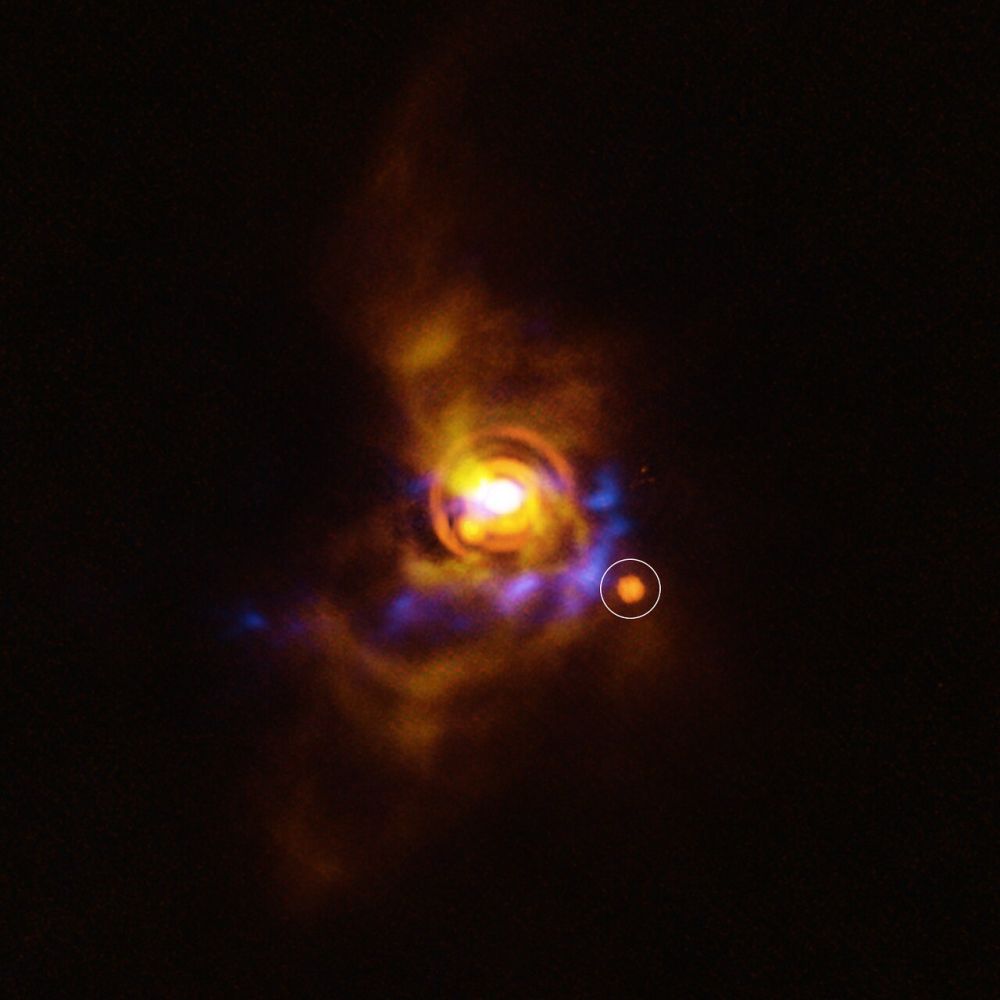 This image shows a possible companion orbiting the young star V960 Mon. Previous analysis of the disc showed that it contains clumps of unstable material that could collapse to form a companion object. The new candidate found here could be either a planet or a brown dwarf. Image Credit: ESO/A. Dasgupta/ALMA (ESO/NAOJ/NRAO)/Weber et al.
This image shows a possible companion orbiting the young star V960 Mon. Previous analysis of the disc showed that it contains clumps of unstable material that could collapse to form a companion object. The new candidate found here could be either a planet or a brown dwarf. Image Credit: ESO/A. Dasgupta/ALMA (ESO/NAOJ/NRAO)/Weber et al.
This work adds to previous research that identified spiral arms around V960 Mons. That research also found clumps that could be portions of the spiral undergoing gravitational instability and possibly forming planets. "Estimating the mass of solids within these clumps to be of several Earth masses, we suggest this observation to be the first evidence of gravitational instability occurring on planetary scales," those authors wrote.
That research set the stage for Dasgupta and his co-researchers to search for and find more direct evidence of a companion forming in the disk.
“That work revealed unstable material but left open the question of what happens next. With ERIS, we set out to find any compact, luminous fragments signaling the presence of a companion in the disc — and we did,” says Dasgupta. However, they aren't sure if it's a planet or a brown dwarf.
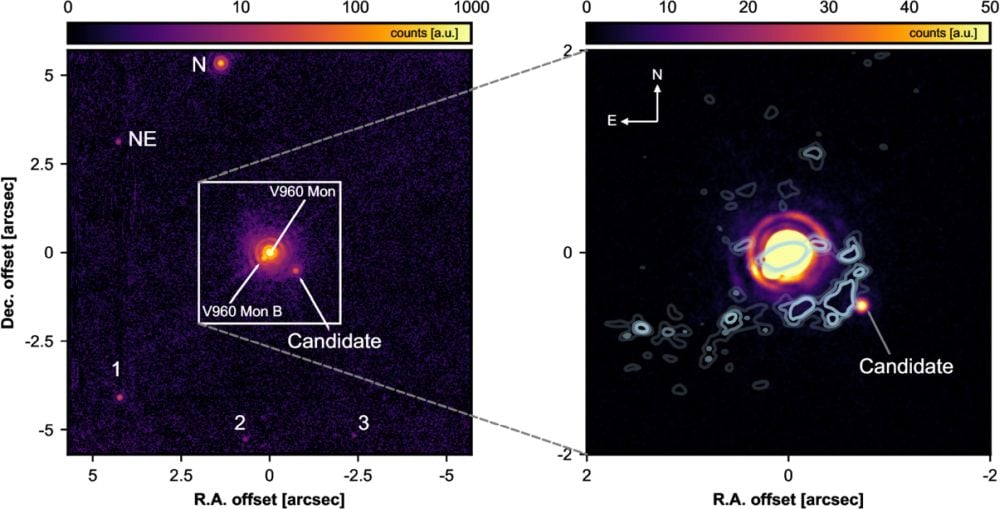 This is a VLT/ERIS image of V960 Mon. The left panel shows the binary star embedded in its environment, marking the detection of V960 Mon N and V960 Mon NE. The right panel shows a zoom-in onto V960 Mon, overlaid with ALMA contours, and the candidate object. Image Credit: ESO/A. Dasgupta/ALMA (ESO/NAOJ/NRAO)/Weber et al.*
This is a VLT/ERIS image of V960 Mon. The left panel shows the binary star embedded in its environment, marking the detection of V960 Mon N and V960 Mon NE. The right panel shows a zoom-in onto V960 Mon, overlaid with ALMA contours, and the candidate object. Image Credit: ESO/A. Dasgupta/ALMA (ESO/NAOJ/NRAO)/Weber et al.*
This detection is important because if it's confirmed, it could be the first direct evidence of planets forming through gravitational instability (GI). The core accretion theory is more widely accepted, but gravitational instability could better explain how Jupiter mass planets could form quickly, and further from their stars.
These two systems and their spirals are linked with GI. Astronomers think they support the GI formation model, but differentiating between the two processes in distant disks is challenging.
The quest to observe planets as they're still forming is linked to our strong desire to understand how our planet formed. Intellectual curiosity drives us to look at our surroundings and wonder how everything got this way. There are many unresolved questions about how Earth formed, and by watching as other planets form, we may be able to uncover some answers.
“We will never witness the formation of Earth, but here, around a young star 440 light-years away, we may be watching a planet come into existence in real time,” said Maio.

